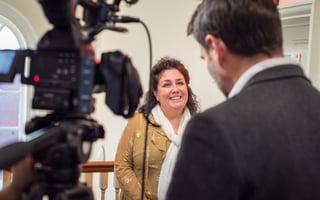Without scoring a goal or even kicking a ball, Marcus Rashford became one of the heroes of the...
Zoom has become a household name in the past few months.
Media interviews, meetings with teams and clients, school lessons and even catch-ups with friends have been taking place online.
Sometimes we are on it for hours a day.
And, even though lockdown restrictions have eased, the convenience and ease Zoom and other video conferencing software offers, means online meeting and interviews are here to stay, as we have highlighted before in this media training blog.
Gradually, we all seem to be getting more comfortable with it. But sometimes it still goes wrong.
Here is a light-hearted look at the online interviews and meetings that stuck in our minds and made headlines when things didn’t quite go to plan.
Children
Balancing working from home with looking after children has been a huge challenge for many of us.
Kids seem to have a natural habit of bursting on to the screen during our meetings and online interviews.
There have been two particularly adorable examples of this which not only warmed the hearts of viewers but captured the interest of the wider media.
Dr Clare Wenham was being interviewed about local lockdowns on BBC News when her daughter Scarlet stole the show.
The little girl could be seen in the background trying to find the best place for her unicorn painting before interrupting her mum.
She asked her mum who she was talking to before explaining that she was trying to find the best place to put her painting.
Dr Wenham showed great patience and professionalism and continued to answer questions despite the distractions.
On the same day, the Sky News foreign affairs editor Deborah Haynes was delivering a report from home when she was interrupted by her son asking for biscuits. She told him he could have two before the report was cut short.
Another example of this peril of working from home, which you may not have seen, came from America.
Author Masha Gessen was giving an interview to MSNBC with the staircase of her home in the background.
The first sign of problems came when the family dog ambled into the camera shot.
This was then followed by one of her children walking down the stairs and quickly playing up for the camera.
And the memorable scene was completed by an older child coming down the stairs, quickly realising what was going on and dragging the youngster off-screen.
Impressively, Ms Gessen didn’t seem at all distracted by the family chaos that was going on behind her.
Masha Gessen just had a Robert Kelly moment on MSNBC. pic.twitter.com/8J4VVuO7E9
— Bob Cesca (@bobcesca_go) July 27, 2020
Media training tip: Although these interruptions can have a humanising impact and help to make spokespeople relatable, try to choose a room where you won’t be interrupted by children, pets and family life.
If your children are old enough, make sure they realise what you are up to and that they know not to disturb you.
Pets
It is not just children who have been disrupting our time on Zoom.
John Nicolson, MP for Ochil and South Perthshire, had been taking part in a virtual Digital, Culture, Media and Sport Committee meeting when his cat wandered past the screen.
The politician was discussing why subtitles were not automatically put on children’s TV programmes when Rojo’s tail began to get in the way.
Mr Nicholson initially apologised for his cat’s appearance before requesting that he put his tail down.
UK SNP Minister John Nicolson’s cat interrupted a committee’s Zoom meeting, “Rojo, put your tail down!” pic.twitter.com/XSuF8NdtUI
— CGTN America (@cgtnamerica) July 14, 2020
Media training tip: Again, if you can, try to find a room, preferably one where you can shut the door, to reduce the chances of being interrupted.
Wardrobe malfunctions
One of the great benefits of working from home is that you can stay in your pyjamas or work in your tracksuit.
If you have to take part in online meetings, you might be tempted to only dress your top half in normal work attire.
But we have a couple of cautionary tales that may cause you to reconsider that approach.
When Good Morning America reporter Will Reeve did a piece about pharmacies using drones to deliver prescriptions, his decision to only wear the top part of his suit backfired.
It became increasingly clear as the report went on that Mr Reeve was not wearing any trousers, much to the amusement of social and mainstream media.
A councillor in New Zealand caused a similar stir when he opted to wear a jacket and little else for an online meeting.
David Benson-Pope may have got away with it if he hadn’t decided to get up and do a spot of dusting during an adjournment.
Zoom meeting fail! pic.twitter.com/cNUavBuQgx
— Chang Hung-Duncan (@ChangHung23) May 5, 2020
The councillor later told the media he had been doing some gardening before the meeting and decided to just put a jacket on over his gardening shorts.
He said he hadn’t noticed he had left the camera on.
“I think it’s probably appropriate to describe it as being caught with your pants down,” he said.
Media training tip: Dress as you would for a media interview in a studio or a face-to-face meeting – it will help you to focus and get in the right frame of mind. If you decide to only dress your top half, make sure your bare legs are not in view and don’t get up from your chair until the meeting or interview has finished.
Troublesome filters
Looking at yourself on screen can feel uncomfortable and make us a bit self-conscious.
But if you think you didn’t quite look your best during that last online meeting, spare a thought for the manager who spent her Zoom call looking like a potato.
Lizet Ocampo, political director at an organization called People for The American Way, had initially downloaded some filters that she used during a fun team-building meeting.
However, she forgot about them ahead of her next meeting after the weekend.
She said: "So Monday morning, we had our meeting and I usually try to do a camera, and when we started the meeting, I saw myself as a potato.
"I was so confused as to why I was a potato.”
Eventually, she realized it was because of the downloaded filters, but that made little difference as she couldn’t find a way to turn them off.
"I just kind of gave up and stayed as a potato for the rest of the call," she said.
One of her colleagues took a screenshot of the strange meeting scene and shared it on Twitter, where it went viral with more than 230,000 retweets and 930,000 likes.
my boss turned herself into a potato on our Microsoft teams meeting and can’t figure out how to turn the setting off, so she was just stuck like this the entire meeting pic.twitter.com/uHLgJUOsXk
— clegg (@PettyClegg) March 30, 2020
Fortunately, the potato boss took it well.
Media training tip: Check your set-up ahead of an interview or meeting and make sure you are happy everything is working as you would expect.
Mute issues
‘Can you put yourself on mute’ must surely be one of the most used phrases of the past few months.
And we all know that one colleague who always forgets about the mute button.
Most of the time it is just annoying and distracting, but occasionally it can be much worse.
Wales’ Health Minister experienced one of the great working from home fails when he vented his frustration about one of his colleagues, forgetting that his microphone was on.
Vaughan Gething could be heard saying “What the f**k is the matter with her?” while Jenny Rathbone the Welsh Assembly member for Cardiff Central was speaking during a virtual session of the assembly.
Colleagues covered their faces, laughed and watched in dismay before presiding officer Elin Jones told Mr Gehting to turn his microphone off.
Ms Rathbone, who was asking questions about the Welsh Government’s response to coronavirus, got up from her seat and walked away from the camera.
Mr Gething later apologised for the blunder and spoke of his embarrassment.
Media training tip: It is good Zoom etiquette to mute yourself when you are not talking during a meeting. Some people worry that this means they will fumble around trying to find a way to unmute themselves when they need to speak. There is an easy way to do this is. If your Zoom box is active, you can simply hold down the space bar to unmute yourself. Once you have finished, let it go and you will be back on mute.
Backgrounds
We’ve probably all been on at least one online call where we have zoned out of what is being said and become mesmerised by what is in the background of the person talking.
Sometimes they have been cluttered, inviting us for a bit of a snoop around their home.
On other occasions, what is in the background might not be appropriate for a work audience and particularly not for a wider one.
Other background errors include choosing a spot other people in the house have to walk past. This is even more distracting when those people might be naked.
For example, journalist Fabio Porchat’s online interview with former Brazilian presidential candidate Guilherme Boulos, was interrupted by his naked wife trying, and failing, to sneak past in the background.
His interviewee couldn’t help laughing and said: “"Somebody's walking past naked."
Check out Moment Brazilian TV host's wife walks across shot naked during interview (via @FabioPorchat)https://t.co/9B5vnUAA70 pic.twitter.com/a12TH7OUA8
— Joy Musa (@Joywesey) July 23, 2020
Media training tip: Always check your background before your online media interview or online meeting. Be wary of books and artwork in the background. Choose a plain, uncluttered background, close to a wall so that people can’t walk behind you, and test how it looks on camera before you go live.
Get in touch with your account manager to find out more about how we can help you with your internal and external communications challenges. Our bespoke, training by videoconference can help you make the most of online technology, whatever your experience level, ensuring you get your personal branding right and that you continue to communicate with confidence and clarity – wherever you are.
Media First are media and communications training specialists with over 30 years of experience. We have a team of trainers, each with decades of experience working as journalists, presenters, communications coaches and media trainers.
Subscribe here to be among the first to receive our blogs.




